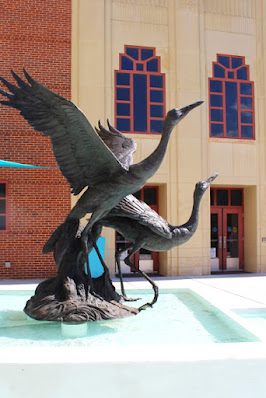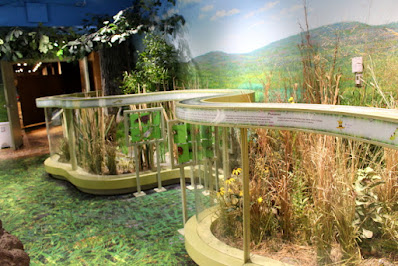I did not have time to visit Brickyard Park or Chautauqua Pavilion before I left Hastings, but I did stop by the Museum of Natural and Cultural History. In front of the building there were several art works, including a bronze statue of the Martin Brothers pinned together on their horse as they were fleeing Indian warriors.
The Natural History exhibits contain a wide collection of animals, many of which are found in Nebraska. There is also a wetlands learning center as part of the exhibit.
The Transportation section contains several antique vehicles not found in most automotive museums.
The 1912 Rauch & Lang B26 Electric Town Car weighed 4,000 pounds, which included 1,000 pounds of batteries that powered an 80-volt motor. Driving range between battery charges was 100 miles. This model was very popular with women because no cranking was required and the vehicle's interior was made with expensive upholstery and the windows had tasseled shades.
A rare wood bodied 1918 Maxwell truck was on display, which is rare because the truck's body was made of wood and not many of them survived. Walter Chrysler purchased the Maxwell Company in 1925 and in 1928 changed the truck's name to Plymouth.
Henry Ford was the chief engineer for Detroit Auto Company when they developed the 1903 Cadillac Runabout, one of which is on display. Ford disagreed with the company's owner over the engine design and was fired. The company was sold to General Motors in 1909 for $4.5 million and Ford started his own automobile company.
David Buick, a Detroit plumber, built the first Buick motorcar in 1903. That same year the company was sold to Flint Wagon Works for $10,000. Charles Nash, Walter Chrysler, and Louis Chevrolet were hired to run the company. Nash, Chrysler, and Chevrolet all went on to later start their own automobile companies
In 1908 Charles Durant started General Motors and used Buick as its first division. The company's motto was: "When better automobiles are built, Buick will build them." In 1909 a Buick won the first race ever held at the Indianapolis Speedway. A 1910 Buick was on display.
Ransom Olds developed the Oldsmobile automobile in 1903, but sold the company so that he cold build an inexpensive, reliable motor car that he named Reo. Reo's Mottos were: "The Gold Standard of Value" and "You can do it in a Reo." A 1906 Reo was on display.
In 1907 Reo set a record by carrying four people 57 miles on 1.75 gallons of gas The Reo went on to travel a total distance of 682 miles at a cost of only $3.38 per passenger. (The placard did not tell how much gas cost per gallon.)
The 1912 International Harvester on display appealed to both farmers and businessmen because the rear seats could be removed and the vehicle could be used as either a truck and passenger car. The vehicles were sold through International's farm equipment dealers and later the vehicle was developed into the International truck.
Alanson Brush designed the first Brush automobile in 1907 and announced that "The Brush will do everything that the larger and more expensive car will do, except go faster than about thirty miles an hour." The vehicle's design never changed and the company went out of business in 1913. Since there were never any design changes, and no vehicle identification number were assigned to the cars, it is not possible to tell what year a vehicle was built.
The museum's cultural exhibits contained Indian artifacts, pioneer items, a general store, large Plains Indian diorama, and a bird display. The Whooping Cranes diorama is the largest of its kind in the world!
There was a beautiful display of rocks, minerals, and fossils from around the world, several of which were found in Nebraska and South Dakota.
One of the main attractions at the Museum is the Kool-Aid exhibit. The path that winds through the exhibit tells the story of how Edwin Perkins in Hastings (Nebraska) invented Fruit Smack in 1927 by doing experiments in his mother's kitchen. The product name was later changed to Kool-Aid.
On May 1, 2000, Kool-Aid Man's footprints were made in a slab of wet cement outside of Grauman's Chinese Theater in Hollywood, California. The prints are now on display at the Museum in Hastings, Nebraska.









































No comments:
Post a Comment